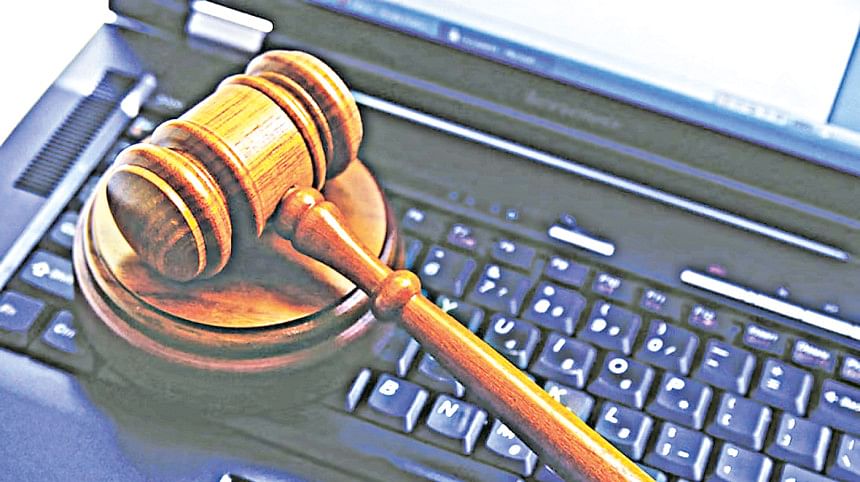Bangladesh and the quest for a digitised judiciary

The judiciary of Bangladesh is heavily loaded with negative tags including of high backlogs, severe delays, huge costs, corruptions, inconsistency, absence of transparency, less conviction of perpetrators and so forth. The insufficient and unplanned use of technologies in the justice system makes the scenario even worse. As a result, the present justice system needs a major transformation from age-old colonial fashioned delivery of justice to adoption of cutting-edge technologies to make its services more people oriented.
The utility of legal tech has already been proved in many jurisdictions, and it has become an integral part of modern judiciary. In 2020, for instance, when the court systems became paralysed due to the COVID19 lockdowns worldwide, technologies were extensively applied as a means to combat the pandemic restrictions, opening new doors for access to justice. Bangladesh also similarly witnessed the blessing of legal tech at that moment. The promulgation of the Adalat Kartrik Tottho-Projukti Bebohar Ain, 2020 was one step forward towards the integration of legal tech in the courts. However, little progress has been seen after that.
There are some risks in incorporation of legal tech into the judiciary too, i.e. data privacy and security concerns, discrimination, bias etc. But certain risks associated with legal tech tools can be effectively avoided through prudent design, procurement, and regulation, but other risks necessitate continuous watchful oversight and ethical application along with robust regulation.
Presently, there are some usages of legal tech in the judiciary, i.e., the Supreme Court (SC) website providing cause list, judgments and orders (https://www.supremecourt.gov.bd), a Government web portal disseminating e-cause list for all subordinate courts (https://causelist.judiciary.gov.bd), a Government website circulating subordinate court's decisions (https://decision.bdcourts.gov.bd), an online monitoring tool to collect and analysis data from subordinate courts (mcsc.supremecourt.gov.bd). Similarly, bail orders can be accessed and verified through the 'Bail Confirmation Online Manual', an online knowledge base platform for the judges (faq.bdcourts.gov.bd). The Government's a2i project has created supporting app such as Judicial Monitoring Dashboard (My Court App), while introducing a platform (www.judiciary.gov.bd) to provide information relating to judicial services including inheritance calculator, judipay, e-filing, e-certified copy etc.
Nonetheless, the abovementioned efforts to digitise the justice sector, although praiseworthy, are not sufficient to overcome the present barriers because of certain limitations within the system. Some of the above initiatives were merely ad hoc project-based, that lost their functionality after the end of the project. Besides, the century-old colonial procedural laws, such as the Codes of Civil and Criminal Procedure, Civil and Criminal Rules and Orders etc. do not directly call for digital intervention in the court proceedings.
However, the digitisation process comes with several impediments. Allocation of low budget and inadequate investment is one of the main challenges to the digitisation of judiciary. Furthermore, lack of properly trained court staff to operate the legal tech tools, absence of adequate supervision and monitoring by the Supreme Court, unfamiliarity with the new systems of the judges, lawyers and staff, necessary training and technical knowledge gap among the lawyers, judges and staff, habitual preference of handling court procedures manually etc contribute to linger the proper digitisation of the judiciary.
Similarly, there are some risks in incorporation of legal tech into the judiciary too, i.e. data privacy and security concerns, discrimination, bias etc. But certain risks associated with legal tech tools can be effectively avoided through prudent design, procurement, and regulation, but other risks necessitate continuous watchful oversight and ethical application along with robust regulation.
As specific recommendations, it is submitted that mandatory e-filing system, video/virtual courtroom, video/remote appearance of accused from prison, arrangement of distance hearing, advanced systems for digital record of evidence of witnesses, application of AI in specific court functions, collaboration and exchange of document electronically with other agencies on digital data sharing and exchange projects can accelerate the process of digitisation of judiciary.
Notably, in 2025, a High Court Division (HCD) bench launched a WhatsApp based slip receiving system. Under the new system, motion, extension of time, and application slips will have to be scanned and sent to a designated WhatsApp number within stipulated time. Earlier this year another HCD bench introduced paper free filing of cases.
To conclude, it can be said that the integration of legal tech in all stages of proceedings and across all courts will promote transparency and accountability, make the complex process of litigation easy, effective, fast, affordable and thereby facilitate the overall court services to the people, and make the judiciary truly a people's institution.
The writer is doctoral researcher in Law at the University of Galway, Ireland and Associate Professor of Law (on leave) at Dhaka International University.

 For all latest news, follow The Daily Star's Google News channel.
For all latest news, follow The Daily Star's Google News channel. 



Comments